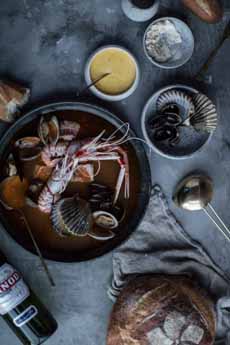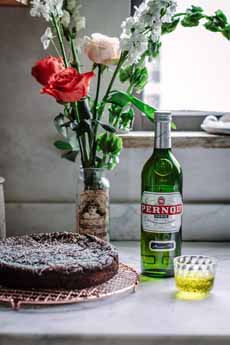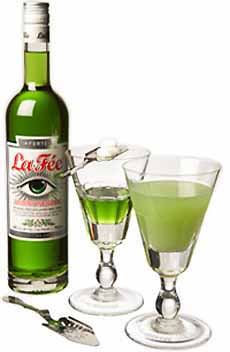TOP PICK OF THE WEEK: Pernod Classic Liqueur
 [1] Pernod created what is now called Pernod Classic in 1915, when a component its absinthe liqueur, wormwood, was declared illegal. See the history of absinthe (photo courtesy Liquor.com).
|
Lovers of licorice who haven’t yet discovered Pernod are in for a treat.
Pernod is a liqueur made in France from star anise, fennel and 14 herbs. It is one of the lighter anise- or licorice-flavored liqueurs, so it’s the right place for licorice lovers to begin. Its sister brand, Ricard Pastis (the companies merged in 1975), has a heavier licorice taste, as do Sambuca and other anise/licorice-flavored liquors. To check them out before you buy a bottle, invite a friend or two for an after-work drink. Order all the types of anise/licorice flavored liqueurs the bar has, and have a tasting. Before we get to how to use Pernod (below), here’s some background to help you understand it. Whether made from anise, fennel, licorice and/or star anise, this group of drinks is very refreshing. That’s one reason why they’re so popular in warm Mediterranean climates. In addition to Pernod, Ricard Pastis and Anisette from France, similar-tasting spirits include absinthe (originating in Switzerland), Sambuca (Italy), anis (Spain), arak (the Levant), kasra (Libya), mistra and ouzo (Greece), ojen (Spain) and raki (Turkey). Pastis, created by Paul Ricard in 1932 and flavored with anise and licorice, is not sweetened like a liqueur. Instead, it is dry and consumed as an apéritif. All of the plants used to make these spirits have similar flavors, but the plants are not related: They’re in different botanical families. So why do these unrelated plants have similar flavors and aromas? It’s because they contain contain the same flavor compound, a substance called anethole. What Is Anethole? Anethole, also called anise camphor, is the organic compound that creates the aroma and flavor of anise and fennel (both in the botanical family Apiaceae), anise myrtle (Myrtaceae family), liquorice (Fabaceae family), and star anise (Illiciaceae family), among other plants and families. The essential oils extracted from the roots, seeds or other parts contain the anethole. To create the liqueur, the oils are distilled with pure alcohol and sweetened with sugar. The liqueurs are served neat, on the rocks, with water, or served with coffee as an after-dinner drink, where they can be drunk after the coffee or mixed into it. When these liqueurs are mixed with water or other liquid (a traditional ratio is 1 part liqueur to 5 parts water), the anethole reacts to make the drink cloudy, a spontaneous emulsification known as the Ouzo Effect (photo #5). The ancestor of modern Pernod liqueur was created by a French physician, Pierre Ordinaire, in 1789. When retired in Switzerland, he created an elixir, a pain-relieving restorative. At the time, such elixirs were a common treatment for ills. (That’s how all spirits and liqueurs began. We now know that the “relief” was largely due to the euphoria-inducing properties of the alcohol.) Dr. Ordinaire called his elixir absinthe, after one of its key ingredients, Artemisia absinthium, grand wormwood. It also contained green anise, sweet fennel, and other medicinal and culinary herbs. Some 10 years later, Dr. Ordinaire sold his formula to Major Daniel-Henry Dubied, who set up the first commercial absinthe distillery with his son-in-law, Henri-Louis Pernod. In 1805 Pernod established his own distillery, Pernod Fils, in France. The original Pernod liqueur (absinthe) became very fashionable in the cafés of Paris. It was so popular that the evening cocktail hour was called “L’heure Verte” (The Green Hour), after absinthe’s green hue. Absinthe was sweetened by pouring it over a sugar cube, held in a perforated spoon (photo #5). It was popular with artists, poets, writers and other members of bohemian society. Some claimed it enhanced their creativity, and the drink was affectionately dubbed “The Green Fairy,” the artists’ muse. Ernest Hemingway, Pablo Picasso and Vincent Van Gogh, among many others, were fans. This rankled producers of other alcoholic beverages, who were losing sales. Over time, they were able to build a specious argument via advertising and newspaper articles about the [alleged] hallucinogen properties of a key ingredient, the herb wormwood (absinthium in Latin). Wormwood contains the chemical thujone, which was believed to cause hallucinations. While this theory was scientifically debunked almost a century later, it wreaked havoc. France and other countries banned the production and consumption of absinthe in 1915. (The U.S. banned it even earlier, in 1912. See the discussion in the footnote* below.) In response, Pernod was reformulated without the wormwood, and launched as Pernod Traditionelle (Pernod Classic in the U.S.). The reformulation also substituted star anise for the green anise that gave, to avoid a green-hued color that would be associated with absinthe. Pernod Traditionelle was pale yellow with a green tinge; and it was sweetened†, no sugar cube required. Following the absinthe tradition, drinkers frequently diluted it with water. |
|
|
When the absinthe ban was debunked and lifted in the early 21st century, French companies resumed producing absinthe, and it became legal to import into the U.S. in 2007. Some American producers also make absinthe. And absinthe even has its own food holiday, March 5th. In Foods Use it as you would use Grand Marnier, brandy, rum, or other liqueur or spirit. Use Pernod instead of another liqueur in a cocktail you enjoy. In photo #4, Pernod was added to a Grasshopper (recipe‡). Here’s a selection of Pernod cocktails. Pernod can also be mixed with fruit juices. *Thujone, a chemical component of wormwood, has been alleged to cause hallucinations. The truth is that, in very high doses, thujone can be toxic and also can cause convulsions. However, in wormwood and other plants, including oregano and common sage, there are only trace amounts and it cannot cause a negative effect. While modern science has proved that there is no evidence at all that thujone can cause hallucinations, even in high doses, the U.S. still prohibits absinthe imported into the country to contain thujone. †The original absinthe was distilled without added sugar, making it a spirit instead of a liqueur. To add sweetness, absinthe was traditionally poured into the glass over a sugar cube held in a perforated spoon. The reformulated Pernod was crafted with added sugar. See a photo. ‡ Combine in a cocktail shaker 1 ounce Pernod Classic, .5 ounce each crème de cacao blanc, crème de menthe and heavy cream. Shake and pour into a coupe glass. Garnish with shaved mint chocolate. |
||






